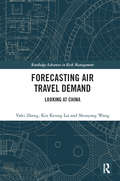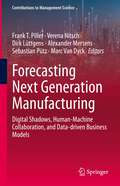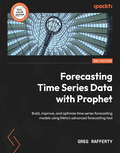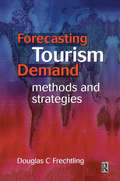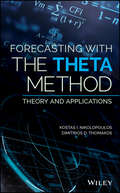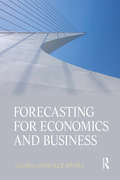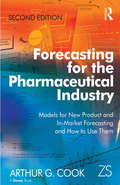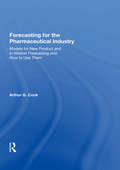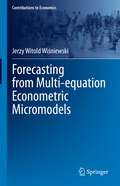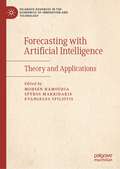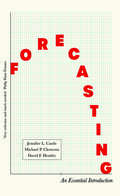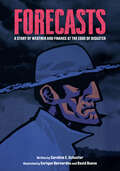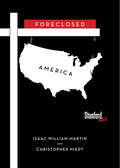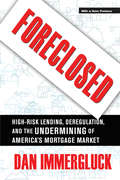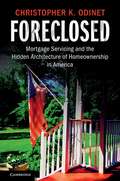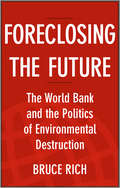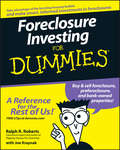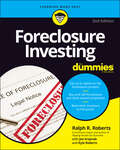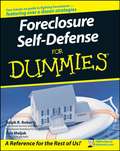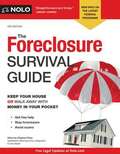- Table View
- List View
Forecasting Air Travel Demand: Looking at China (Routledge Advances in Risk Management)
by Shouyang Wang Kin Keung Lai Yafei ZhengThis book provides an updated, concise summary of forecasting air travel demand methodology. It looks at air travel demand forecasting research and attempts to outline the whole intellectual landscape of demand forecasting. It helps readers to understand the basic idea of TEI@I methodology used in forecasting air travel demand and how it is used in developing air travel demand forecasting methods. The book also discusses what to do when facing different forecasting problems making it a useful reference for business practitioners in the industry.
Forecasting Inflation in Sudan
by Kenji Moriyama Abdul NaseerA report from the International Monetary Fund.
Forecasting Next Generation Manufacturing: Digital Shadows, Human-Machine Collaboration, and Data-driven Business Models (Contributions to Management Science)
by Frank T. Piller Alexander Mertens Verena Nitsch Dirk Lüttgens Sebastian Pütz Marc Van DyckManufacturing companies have just begun to implement the concepts of the Fourth Industrial Revolution (Industry 4.0) on a larger scale. Still, this area is characterized by a rapid pace of technological change, blurring boundaries between physical, digital, and biological systems, and a quickly changing growing political, economic, and social environment -- leading to high uncertainty in decision making and many questions about the future development in this field. To provide guidance and inspiration for managers and academics on the future of digital manufacturing systems, this book presents the results of an extensive Delphi study on next-generation manufacturing systems, with a projection period of up to 2030. We analyzed almost 2000 quantitative estimations and more than 600 qualitative arguments from a large panel of industrial and academic experts from Europe, North America, and Asia. The book describes each of the 24 projections in detail, offering current case study examples and related research, as well as implications for policymakers, firms, and individuals. The empirical results also allowed us to build scenarios for the most probable future along the dimensions of governance, organization, capabilities, and interfaces from both a company-internal and an external (network) perspective.
Forecasting Time Series Data with Prophet: Build, improve, and optimize time series forecasting models using Meta's advanced forecasting tool, 2nd Edition
by Greg RaffertyCreate and improve fully automated forecasts for time series data with strong seasonal effects, holidays, and additional regressors using PythonPurchase of the print or Kindle book includes a free PDF eBookKey FeaturesExplore Prophet, the open source forecasting tool developed at Meta, to improve your forecastsCreate a forecast and run diagnostics to understand forecast qualityFine-tune models to achieve high performance and report this performance with concrete statisticsBook DescriptionProphet empowers Python and R developers to build scalable time series forecasts. This book will help you to implement Prophet's cutting-edge forecasting techniques to model future data with high accuracy using only a few lines of code.You'll begin by exploring the evolution of time series forecasting, from basic early models to present-day advanced models. After the initial installation and setup, you'll take a deep dive into the mathematics and theory behind Prophet. You'll then cover advanced features such as visualizing your forecasts, adding holidays and trend changepoints, and handling outliers. You'll use the Fourier series to model seasonality, learn how to choose between an additive and multiplicative model, and understand when to modify each model parameter. This updated edition has a new section on modeling shocks such as COVID. Later on in the book you'll see how to optimize more complicated models with hyperparameter tuning and by adding additional regressors to the model. Finally, you'll learn how to run diagnostics to evaluate the performance of your models and discover useful features when running Prophet in production environments.By the end of this book, you'll be able to take a raw time series dataset and build advanced and accurate forecasting models with concise, understandable, and repeatable code.What you will learnUnderstand the mathematics behind Prophet's modelsBuild practical forecasting models from real datasets using PythonUnderstand the different modes of growth that time series often exhibitDiscover how to identify and deal with outliers in time series dataFind out how to control uncertainty intervals to provide percent confidence in your forecastsProductionalize your Prophet models to scale your work faster and more efficientlyWho this book is forThis book is for business managers, data scientists, data analysts, machine learning engineers, and software engineers who want to build time-series forecasts in Python or R. To get the most out of this book, you should have a basic understanding of time series data and be able to differentiate it from other types of data. Basic knowledge of forecasting techniques is a plus.
Forecasting Tourism Demand: Methods And Strategies
by Douglas Frechtling'Forecasting tourism demand' is a text that no tourism professional can afford to be without. The tourism industry has experienced an overwhelming boom over recent years, and being able to predict future trends as accurately as possible is vital in the struggle to stay one step ahead of the competition. Building on the success of 'Practical Tourism Forecasting' this text looks at 13 methods of forecasting and with a user friendly style, 'Forecasting Tourism Demand' guides the reader through each method, highlighting its strengths and weaknesses and explaining how it can be applied to the tourism industry.'Forecasting Tourism Demand' employs charts and tables to explain how to:* plan a forecasting project* analyse time series and other information* select the appropriate forecasting model* use the model for forecasting and evaluate its resultsIdeal for marketing managers and strategic planners in business, transportation planners and economic policy makers in government who must project demand for their products among tourists. Executives who rely on forecasts prepared by others will find it invaluable in assisting them to evaluate the validity and reliability of predictions and forecasts. Those engaged in analysing business trends will find it useful in surveying the future of what has been called the largest industry in the world.
Forecasting With The Theta Method: Theory and Applications
by Dimitrios D. Thomakos Kostas I. NikolopoulosThe first book to be published on the Theta method, outlining under what conditions the method outperforms other forecasting methods This book is the first to detail the Theta method of forecasting – one of the most difficult-to-beat forecasting benchmarks, which topped the biggest forecasting competition in the world in 2000: the M3 competition. Written by two of the leading experts in the forecasting field, it illuminates the exact replication of the method and under what conditions the method outperforms other forecasting methods. Recent developments such as multivariate models are also included, as are a series of practical applications in finance, economics, and healthcare. The book also offers practical tools in MS Excel and guidance, as well as provisional access, for the use of R source code and respective packages. Forecasting with the Theta Method: Theory and Applications includes three main parts. The first part, titled Theory, Methods, Models & Applications details the new theory about the method. The second part, Applications & Performance in Forecasting Competitions, describes empirical results and simulations on the method. The last part roadmaps future research and also include contributions from another leading scholar of the method – Dr. Fotios Petropoulos. First ever book to be published on the Theta Method Explores new theory and exact conditions under which methods would outperform most forecasting benchmarks Clearly written with practical applications Employs R – open source code with all included implementations Forecasting with the Theta Method: Theory and Applications is a valuable tool for both academics and practitioners involved in forecasting and respective software development.
Forecasting for Economics and Business
by Gloria González-RiveraFor junior/senior undergraduates in a variety of fields such as economics, business administration, applied mathematics and statistics, and for graduate students in quantitative masters programs such as MBA and MA/MS in economics. A student-friendly approach to understanding forecasting. Knowledge of forecasting methods is among the most demanded qualifications for professional economists, and business people working in either the private or public sectors of the economy. The general aim of this textbook is to carefully develop sophisticated professionals, who are able to critically analyze time series data and forecasting reports because they have experienced the merits and shortcomings of forecasting practice.
Forecasting for the Pharmaceutical Industry: Models for New Product and In-Market Forecasting and How to Use Them
by Arthur G. CookForecasting for the Pharmaceutical Industry is a definitive guide for forecasters as well as the multitude of decision makers and executives who rely on forecasts in their decision making. In virtually every decision, a pharmaceutical executive considers some type of forecast. This process of predicting the future is crucial to many aspects of the company - from next month's production schedule, to market estimates for drugs in the next decade. The pharmaceutical forecaster needs to strike a delicate balance between over-engineering the forecast - including rafts of data and complex ’black box’ equations that few stakeholders understand and even fewer buy into - and an overly simplistic approach that relies too heavily on anecdotal information and opinion. Arthur G. Cook's highly pragmatic guide explains the basis of a successful balanced forecast for products in development as well as currently marketed products. The author explores the pharmaceutical forecasting process; the varied tools and methods for new product and in-market forecasting; how they can be used to communicate market dynamics to the various stakeholders; and the strengths and weaknesses of different forecast approaches. The text is liberally illustrated with tables, diagrams and examples. The final extended case study provides the reader with an opportunity to test out their knowledge. The second edition has been updated throughout and includes a brand new chapter focusing on specialized topics such as forecasting for orphan drugs and biosimilars.
Forecasting for the Pharmaceutical Industry: Models for New Product and In-Market Forecasting and How to Use Them
by Arthur G. CookIn virtually every decision, a pharmaceutical executive considers some type of forecast. This process of predicting the future is crucial to many aspects of the company - from next month's production schedule, to market estimates for drugs in the next decade. The pharmaceutical forecaster needs to strike a delicate balance between over-engineering the forecast - including rafts of data and complex 'black box' equations that few stakeholders understand and even fewer buy into - and an overly simplistic approach that relies too heavily on anecdotal information and opinion. Art Cook's highly pragmatic guide explains the basis of a successful balanced forecast for products in development as well as currently marketed products. The author explores the pharmaceutical forecasting process; the varied tools and methods for new product and in-market forecasting; how they can be used to communicate market dynamics to the various stakeholders; and the strengths and weaknesses of different forecast approaches. The text is liberally illustrated with tables, diagrams and examples. The final extended case study provides the reader with an opportunity to test out their knowledge. Forecasting for the Pharmaceutical Industry is a definitive guide for forecasters as well as the multitude of decision makers and executives who rely on forecasts in their decision making.
Forecasting from Multi-equation Econometric Micromodels (Contributions to Economics)
by Jerzy Witold WiśniewskiForecasting from multi-equation models has very rarely been the focus in econometric literature. In response, this book presents a range of methodologies to approach this complex field and offers readers essential information on forecasting from multi-equation econometric micromodels.In the twentieth century, significant interest in econometric macromodels emerged. These multi-equation models are mostly systems of interdependent equations, most often used to describe the national economies of various countries. The book analyzes econometric forecasting procedures and illustrates them with empirical examples that are based on real economic (mostly business-derived) data. The procedure of forecast building from systems of interdependent equations is presented for two categories of econometric models: models with a feedback effect and models with closed-loop links between interdependent variables. The forecasts obtained via this technique are compared with the results derived from reduced-form equations of the respective econometric model. The author also generalizes the rules of the reduced-recursive (helical, iterative) procedure application, against the backdrop of the proposed method of forecast building from reduced-form equations of systems of interdependent equations. Given its scope, the book will appeal not only to PhD students and researchers, but also undergraduate students and academics in general.
Forecasting the Adoption of a New Product
by Elie OfekProvides tools and methodologies that allow forecasting demand for innovative new products. Highlights the Bass model--the theory behind it and ways to determine its parameters. Provides a detailed example of how to use the Bass model to forecast demand for satellite radio. Also covers ways to incorporate marketing mix variables and competition and explores the impact of these factors on the adoption and diffusion of an innovation. Finally, illustrates how to construct forecasts when early sales data are available via data-driven forecasting models.
Forecasting the Future & Redefining Your Future: Paid to Think
by David GoldsmithIn reality, the conditions we live with today are simply the results of decisions made in the past and, in leadership terms, this means that the better able you are to project your thinking into the future and forecast upcoming challenges and opportunities on the horizon, the more effectively you can decide today how to forge tomorrow. Get the tools and concepts that have a high-beam effect on your thinking, project your focus more accurately into the future, and cash in on the positive benefits of your improved strategic planning now and in years to come.
Forecasting with Artificial Intelligence: Theory and Applications (Palgrave Advances in the Economics of Innovation and Technology)
by Spyros Makridakis Mohsen Hamoudia Evangelos SpiliotisThis book is a comprehensive guide that explores the intersection of artificial intelligence and forecasting, providing the latest insights and trends in this rapidly evolving field. The book contains fourteen chapters covering a wide range of topics, including the concept of AI, its impact on economic decision-making, traditional and machine learning-based forecasting methods, challenges in demand forecasting, global forecasting models, meta-learning and feature-based forecasting, ensembling, deep learning, scalability in industrial and optimization applications, and forecasting performance evaluation. With key illustrations, state-of-the-art implementations, best practices, and notable advances, this book offers practical insights into the theory and practice of AI-based forecasting. This book is a valuable resource for anyone involved in forecasting, including forecasters, statisticians, data scientists, business analysts, or decision-makers.
Forecasting with Regression Analysis
by Arthur Schleifer Jr.Provides an example of regression in one of its most important roles. Relating probabilistic forecasts based on past data to decision analysis.
Forecasting: An Essential Introduction (Blackwell Companions To Contemporary Economics Ser. #Vol. 2)
by David Hendry Jennifer Castle Michael ClementsConcise, engaging, and highly intuitive—this accessible guide equips you with an understanding of all the basic principles of forecasting Making accurate predictions about the economy has always been difficult, as F. A. Hayek noted when accepting his Nobel Prize in economics, but today forecasters have to contend with increasing complexity and unpredictable feedback loops. In this accessible and engaging guide, David Hendry, Michael Clements, and Jennifer Castle provide a concise and highly intuitive overview of the process and problems of forecasting. They explain forecasting concepts including how to evaluate forecasts, how to respond to forecast failures, and the challenges of forecasting accurately in a rapidly changing world. Topics covered include: What is a forecast? How are forecasts judged? And how can forecast failure be avoided? Concepts are illustrated using real-world examples including financial crises, the uncertainty of Brexit, and the Federal Reserve’s record on forecasting. This is an ideal introduction for university students studying forecasting, practitioners new to the field and for general readers interested in how economists forecast.
Forecasts: A Story of Weather and Finance at the Edge of Disaster (ethnoGRAPHIC)
by Caroline SchusterBased in the agrarian world of commercial sesame farming in northern Paraguay, Forecasts tells a story about what happens when global insurance companies promise financial safety nets to local farmers struggling with the effects of climate change. This striking graphic novel brings together original ethnographic research and Paraguayan gothic art to confront the limitations of finance to respond to a deteriorating environment. Taking a human-centered approach to complex weather and financial models, Forecasts offers new ways of looking at overlapping speculative futures in a more-than-human landscape. Based on more than a year of fieldwork in Paraguay, the book follows one man’s possible journeys through a season of planting and harvesting, buffeted by losses and sustained by the hope that he can cultivate conditions that will help his family thrive. Forecasts makes a sweeping account of environmental and financial risk accessible through the intimate story of one family’s triumphs, heartbreaks, and hopes for the future.
Foreclosed America
by Isaac William Martin Christopher NiedtFrom 2007 to 2012, almost five percent of American adults-about ten million people-lost their homes because they could not make mortgage payments. The scale of this home mortgage crisis is unprecedented-and it's not over. Foreclosures still displace more American homeowners every year than at any time before the twenty-first century. The dispossession and forced displacement of American families affects their health, educational success, and access to jobs. It continues to block any real recovery in the hardest-hit communities. While we now know a lot about how this crisis affected the global economy, we still know very little about how it affected the people who lost their homes. Foreclosed America offers the first representative portrait of those people-who they are, how and where they live after losing their homes, and what they have to say about their finances, their neighborhoods, and American politics. It is a sobering picture of Americans down on their luck, and of a crisis that is testing American democracy.
Foreclosed: High-Risk Lending, Deregulation, and the Undermining of America's Mortgage Market
by Dan ImmergluckIn 2007 and 2008, the United States has observed, with some horror, the explosion and collapse of entire segments of the housing market, especially those driven by subprime and alternative or "exotic" home mortgage lending. Foreclosed explains the rise of high-risk lending and why these newer types of loans-and their associated regulatory infrastructure-failed in substantial ways. Dan Immergluck narrates the boom in subprime and exotic loans, recounting how financial innovations and deregulation facilitated excessive risk-taking, and how these loans have harmed different populations and communities.Immergluck, who has been working, researching, and writing on issues tied to housing finance and neighborhood change for almost twenty years, has an intimate knowledge of the promotion of homeownership and the history of mortgages in the United States. The changes to the mortgage market over the past fifteen years-including the securitization of mortgages and the failure of regulators to maintain control over a much riskier array of mortgage products-led, he finds, inexorably to the current crisis.After describing the development of generally stable and risk-limiting mortgage markets throughout much of the twentieth century, Foreclosed details how federal policy-makers failed to regulate the new high-risk lending markets that arose in the late 1990s and early 2000s. The book also examines federal, state, and local efforts to deal with the mortgage and foreclosure crisis of 2007 and 2008. Immergluck draws upon his wealth of experience to provide an overarching set of principles and a detailed set of policy recommendations for "righting the ship" of U.S. housing finance in ways that will promote affordable yet sustainable homeownership as an option for a broad set of households and communities. The 2011 edition features a new preface by the author addressing the ongoing global economic crisis and the impact of U.S. financial reform efforts on the mortgage system.
Foreclosed: Mortgage Servicing and the Hidden Architecture of Homeownership in America
by Christopher K. OdinetIn Foreclosed, Christopher K. Odinet gives voice to the stories of homeowners that have been neglected, particularly those facing foreclosure and deep financial distress. The book reveals the powerful and often invisible mortgage servicing industry, the tremendous discretionary power it wields over the housing lives of most Americans, and the servicing problems that still persist today. In doing so, it unveils a quiet and dangerous market shift in mortgage servicing - namely, an ongoing move toward a shadow banking sector where regulation is weak - that threatens the stability of our housing finance system. Ultimately, the book demonstrates how the law does not afford homeowners the protection most think and how regulation of these mortgage middlemen remains weak. Foreclosed should be read by anyone concerned with the state of housing and home ownership in the United States.
Foreclosing the Future
by Bruce RichWorld Bank President Jim Yong Kim has vowed that his institution will fight poverty and climate change, a claim that World Bank presidents have made for two decades. But if worldwide protests and reams of damning internal reports are any indication, too often it does just the opposite. By funding development projects and programs that warm the planet and destroy critical natural resources on which the poor depend, the Bank has been hurting the very people it claims to serve. What explains this blatant contradiction? If anyone has the answer, it is arguably Bruce Rich—a lawyer and expert in public international finance who has for the last three decades studied the Bank’s institutional contortions, the real-world consequences of its lending, and the politics of the global environmental crisis. What emerges from the bureaucratic dust is a disturbing and gripping story of corruption, larger-than-life personalities, perverse incentives, and institutional amnesia. The World Bank is the Vatican of development finance, and its dysfunction plays out as a reflection of the political hypocrisies and failures of governance of its 188 member countries. Foreclosing the Future shows how the Bank’s failure to address the challenges of the 21st Century has implications for everyone in an increasingly interdependent world. Rich depicts how the World Bank is a microcosm of global political and economic trends—powerful forces that threaten both environmental and social ruin. Rich shows how the Bank has reinforced these forces, undercutting the most idealistic attempts at alleviating poverty and sustaining the environment, and damaging the lives of millions. Readers will see global politics on an increasingly crowded planet as they never have before—and come to understand the changes necessary if the World Bank is ever to achieve its mission.
Foreclosure Investing For Dummies
by Joe Kraynak Ralph R. RobertsWith the housing bubble of the past few years bursting and interest rates on the rise, there has been an upsurge in the number of foreclosures across the country, creating many opportunities for profit. But investing in real estate foreclosure[s?] can be a tough job, especially when a negative stigma is attached. How do you make money while preserving your morals and trust?Foreclosure Investing For Dummies shows you how to invest in foreclosures ethically without being accused of stealing homes from "little old ladies." This step-by-step guide helps you thoroughly research property, find the best opportunities, purchase foreclosures, and avoid misleading distressed homeowners. This book doesn't promise quick profits through minimal work, but it will provide you with invaluable information to become a successful investor, including:Identifying opportunities and understanding risksObtaining information, tools, support, and resourcesLocating properties prior to foreclosureAssisting homeowners through the foreclosure processAcquiring properties below market value prior to the auctionBuying property at an auction, from lending institutions, and government agenciesRepairing, renovating, and selling or leasing propertyThis book provides tips and strategies for refinancing your property and maximizing your profits. It also gives you advice on how to assist homeowners, have them work with you, and common mistakes you should avoid. It's time to go out and make the most of foreclosure investing, and with Foreclosure Investing For Dummies by your side, your hard work and devotion will bring tons of success!
Foreclosure Investing For Dummies
by Ralph R. RobertsMake foreclosure investing work for you with this practical and easy-to-understand guide Looking to kick start your own property management career? Check out Foreclosure Investing For Dummies, which will get you started buying foreclosed properties to turn into your own income property! In this book, you'll learn to navigate the complexities of home auctions, deal with emotional former homeowners, and how to handle renovations. You'll also get a heads-up on the foreclosure laws in all 50 states so you don't accidentally run afoul of any complicated regulations. Foreclosure Investing For Dummies shows you how to: Locate properties for sale and identify associated opportunities and risks Buy properties below market value at auction, from lending institutions, and from government agencies Fix up, renovate, and sell or lease your new property for a profit This hands-on guide can help anyone make foreclosure investing work. So, grab a copy of Foreclosure Investing For Dummies, roll up your sleeves, and get going!
Foreclosure Self-Defense For Dummies
by Joe Kraynak Ralph R. Roberts Lois Maljak Paul DorohFacing foreclosure? You need to do three things: stop worrying about why this has happened to you; resolve to fight the foreclosure and save your home; and read Foreclosure Self-Defense For Dummies. It delivers the knowledge, strategies, and tactics you'll need to take command of your situation and achieve the best possible outcome. This practical, no-nonsense guide helps you size up your options and increase your chances of saving your home. You'll find out how to delay foreclosure, form a plan of attack, negotiate solutions with your lender, and restore your financial health. You'll also find field-tested strategies for dodging the foreclosure trap, getting out from under a house you really can't afford, and finding help where you might least expect it. Discover how to: Regain your emotional composure Confront your foreclosure head-on Protect your rights Assess your situation and weigh your options Touch base with key people who can help you Stop the financial bleeding Team up with your lender to find solutions Work out a refinancing deal with another lender Avoid quick-fix schemes and scams Cash out before it's too late Recover from foreclosure Re-establish your credit Complete with a handy cheat-sheet to help you keep your most important tasks in the front of your mind Foreclosure Self-Defense for Dummies gives you the moral support, commonsense guidance, and expert advice you need to make the best of this difficult situation.
Foreclosure Survival Guide, The
by Stephen Elias Leon Bayer Amy LoftsgordonFacing foreclosure? You have options. If you're one of the millions Americans who are having trouble making your mortgage payments or are already in jeopardy of foreclosure, this guide will give you the practical information you need, including: * the ins and outs of foreclosure * how to decide if you should try to keep your house * federal programs to help you avoid foreclosure * alternatives to foreclosure, such as short sales and deeds in lieu * delaying or avoiding foreclosure with bankruptcy, and * avoiding foreclosure scams. This edition of the nation's bestselling book on foreclosure is updated with the latest information on the federal Making Home Affordable programs, recent court decisions affecting homeowner's rights, and state foreclosure procedures and timelines.
